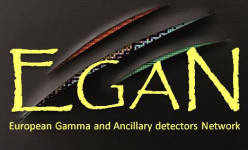Speaker
Steffen Ketelhut
(Department of Physics, University of Jyväskylä)
Description
Nuclei in the neighbourhood of 254No are the heaviest nuclei, which have been studied by in-beam spectroscopic methods, and in which the decay paths of several K isomers have be delineated. These nuclei can be produced with relatively high cross section due to favourable projectile-target combinations, and give valuable information on single-particle and collective properties in a region just below the heaviest elements which have been produced in laboratory. This region is therefore an important testing ground for the predictions of state-of-the-art models describing superheavy elements. JUROGAM is an array of Compton-suppressed HPGe detectors at JYFL, which was upgraded to JUROGAM II in 2008. JUROGAM II has improved efficiency and can handle higher count rates because of the use of digital electronics. In combination with the gas-filled recoil-separator RITU and the focal-plane detector set-up GREAT, it is a powerful tool to make in-beam studies of very heavy nuclei with the help of the so-called Recoil-Decay Tagging (RDT) technique. Recently, ground-state bands could be established or extended in 246,248,250Fm. The results extend the systematics of nuclei in this region in terms of moment of inertia and excitation energies of rotational states. The results give as well a proof of principle, that other ground-state bands in the region (such as 256Rf) will be available for spectroscopy in the future, as new cross section limits have been reached. The spectroscopy of odd-even nuclei is more challenging due to the highly-fragmented spectra. Nevertheless, two rotational bands could be established in 255Lr, which is the heaviest nucleus so far to be studied in-beam. The level scheme at lower excitation energy is still under debate, and future in-beam and focal-plane studies will shed light on the exact positioning and spins of these bands.
Author
Steffen Ketelhut
(Department of Physics, University of Jyväskylä)

